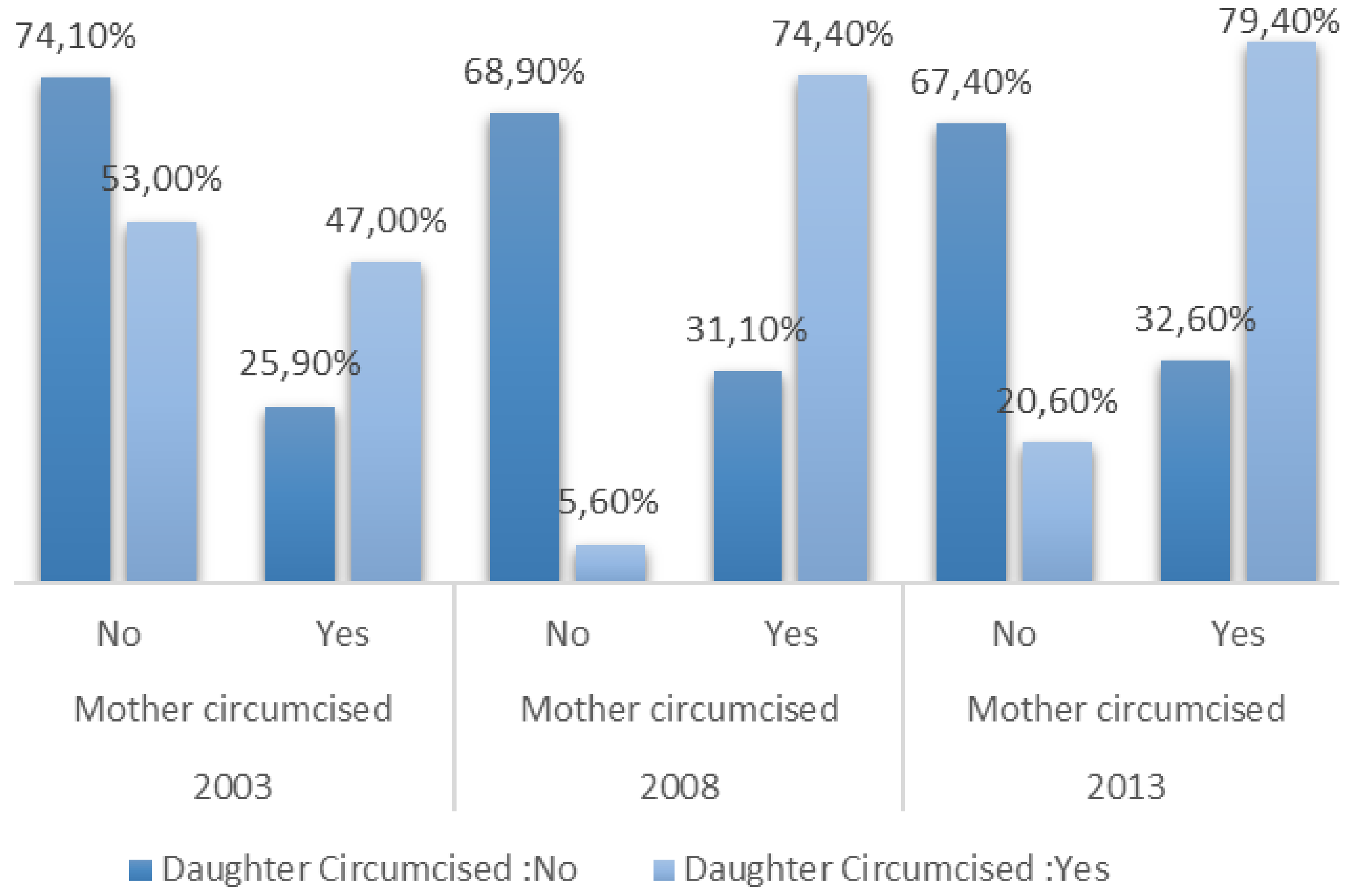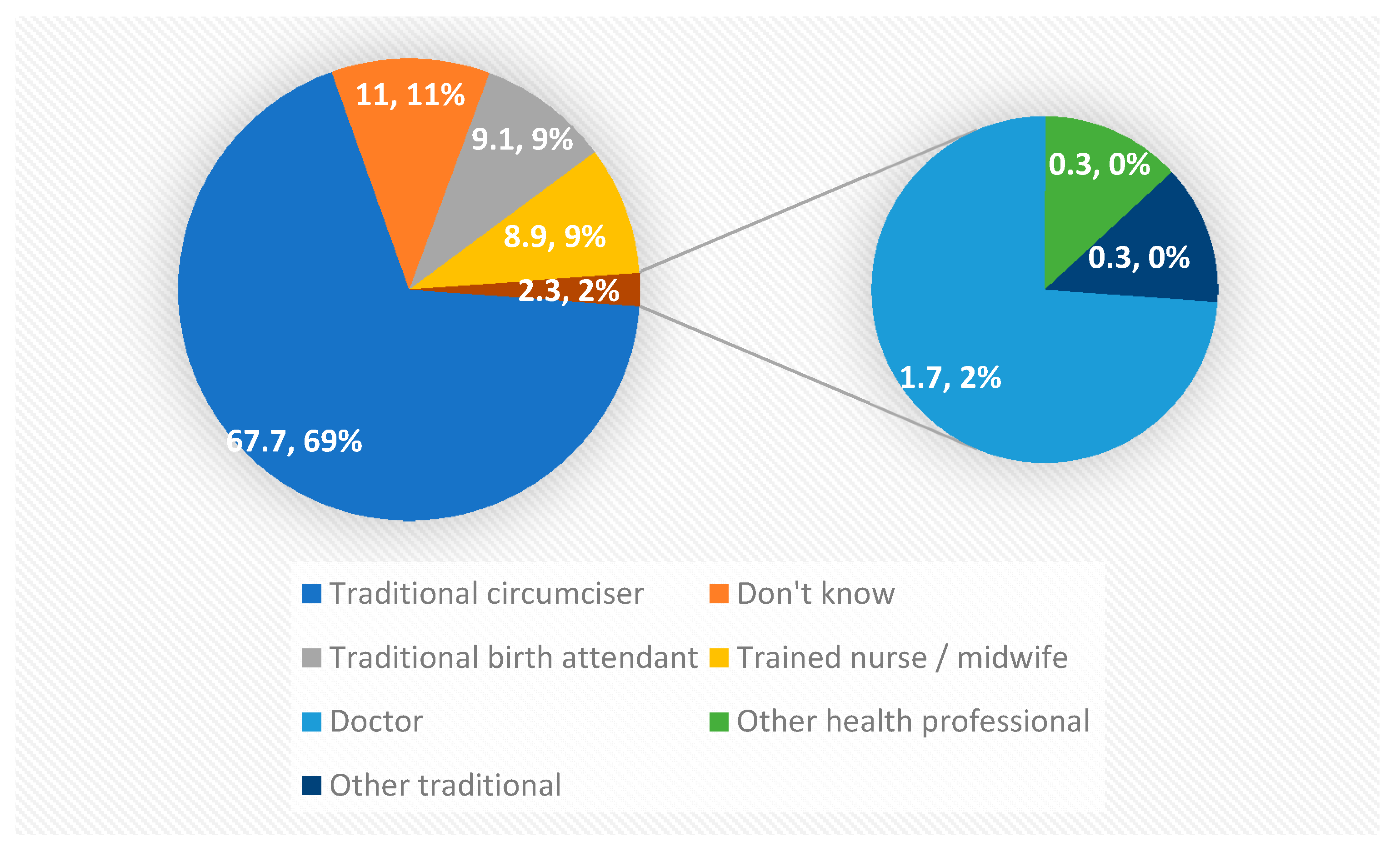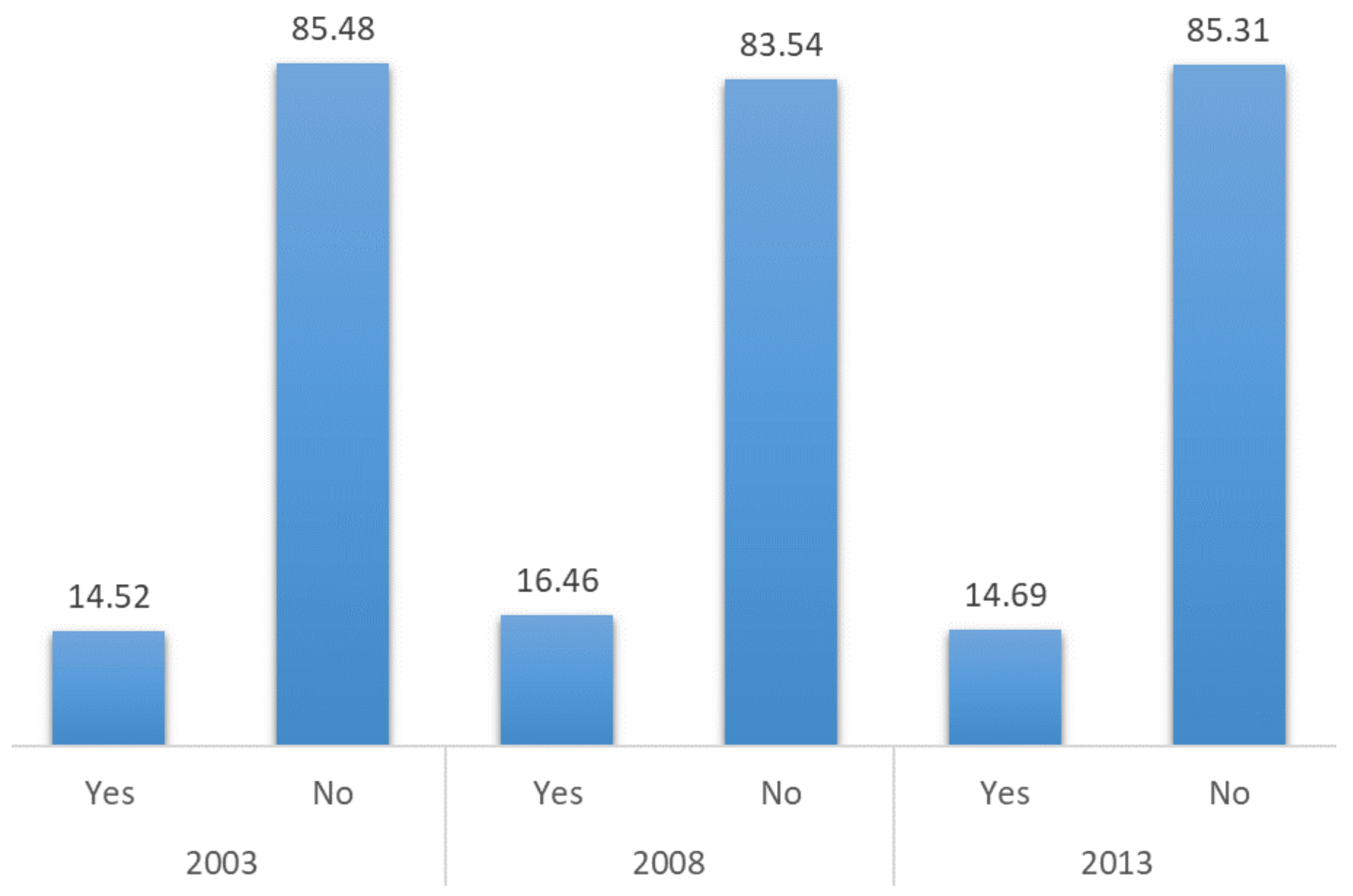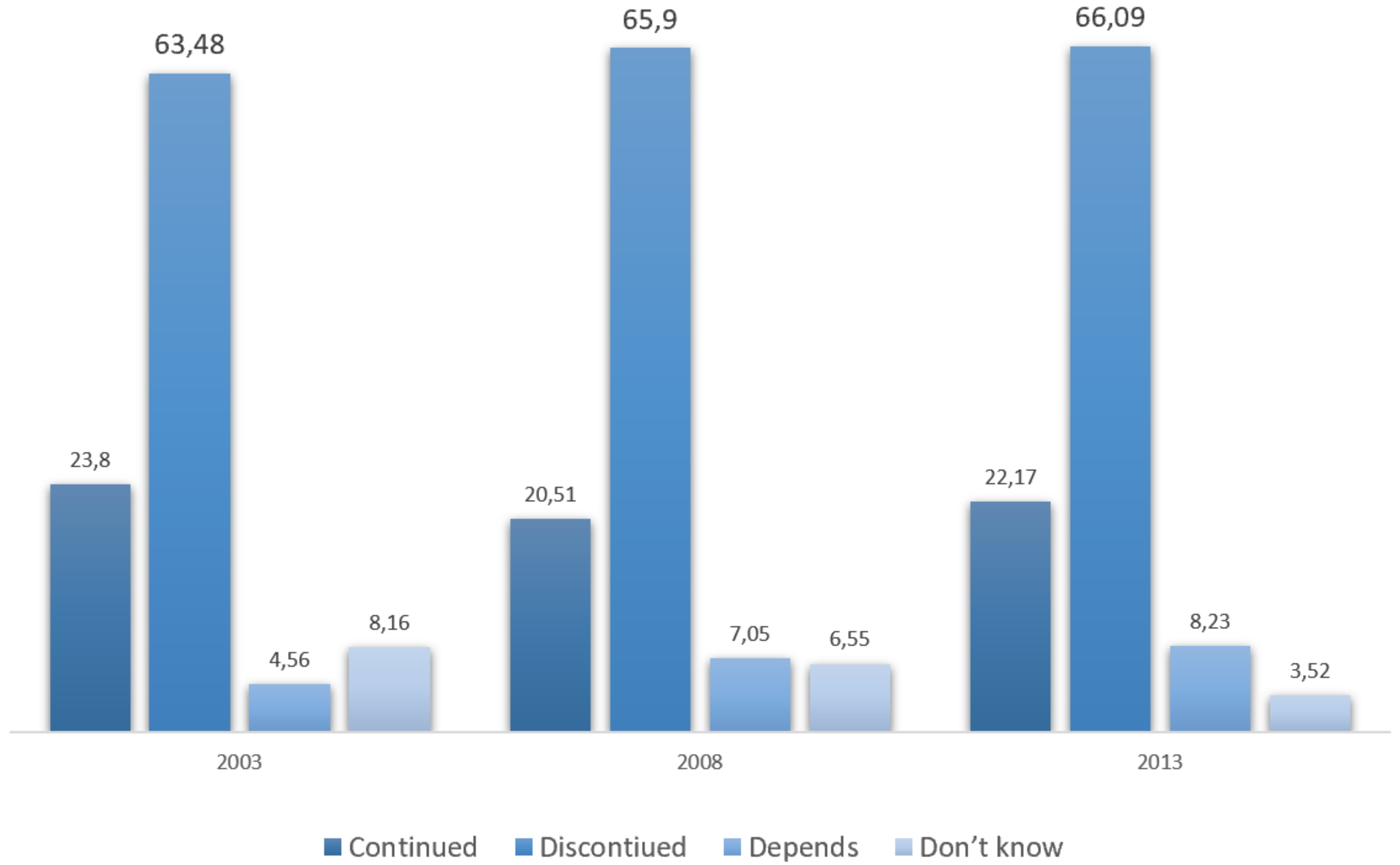Female Genital Mutilation in Nigeria: A Persisting Challenge for Women’s Rights
Abstract
1. Introduction
2. Methods
2.1. Data Source
2.2. Selection and Description of Variables
2.3. Statistical Analysis
2.4. Ethics Approval
3. Results
3.1. Descriptive Characteristics of the Sample
3.2. Factors Associated with FGM among Respondents and Their Daughters
4. Discussion and Policy Recommendation
5. Conclusions
Author Contributions
Funding
Acknowledgments
Conflicts of Interest
Appendix A
| N = 50,281 | % | % of Respondent Undergone FGM (38.9%) | p | % of Daughters Undergone FGM (17.4%) | p | |||||
|---|---|---|---|---|---|---|---|---|---|---|
| Year | <0.0001 | <0.0001 | ||||||||
| 2003 | 7321 | 14.6 | 8.4 | 7.6 | 9.4 | 7.0 | 6.1 | 8.2 | ||
| 2008 | 18,487 | 36.8 | 43.4 | 41.0 | 45.8 | 45.1 | 41.7 | 48.6 | ||
| 2013 | 24,473 | 48.7 | 48.2 | 45.9 | 50.5 | 47.8 | 44.5 | 51.2 | ||
| Age | <0.0001 | <0.0001 | ||||||||
| 15–19 | 8342 | 16.6 | 13.5 | 12.8 | 14.2 | 4.0 | 3.5 | 4.6 | ||
| 20–24 | 8709 | 17.3 | 15.5 | 14.9 | 16.2 | 10.2 | 9.3 | 11.2 | ||
| 25–29 | 9456 | 18.8 | 17.5 | 16.8 | 18.2 | 18.4 | 17.3 | 19.6 | ||
| 30–34 | 7305 | 14.5 | 15.0 | 14.4 | 15.6 | 18.0 | 16.9 | 19.2 | ||
| 35–39 | 6436 | 12.8 | 13.7 | 13.1 | 14.2 | 18.4 | 17.3 | 19.6 | ||
| 40–44 | 5059 | 10.1 | 12.2 | 11.6 | 12.7 | 15.3 | 14.3 | 16.4 | ||
| 45–49 | 4974 | 9.9 | 12.7 | 12.1 | 13.3 | 15.6 | 14.5 | 16.8 | ||
| Region | <0.0001 | <0.0001 | ||||||||
| North Central | 5892 | 11.7 | 8.6 | 7.3 | 10.2 | 8.3 | 6.5 | 10.6 | ||
| North East | 6938 | 13.8 | 1.7 | 1.2 | 2.4 | 3.8 | 2.9 | 5.0 | ||
| North West | 10,307 | 20.5 | 14.6 | 12.7 | 16.7 | 16.8 | 14.6 | 19.1 | ||
| South East | 7902 | 15.7 | 24.9 | 23.0 | 26.9 | 31.9 | 28.5 | 35.6 | ||
| South South | 9485 | 18.9 | 18.0 | 16.4 | 19.7 | 10.0 | 8.4 | 11.8 | ||
| South West | 9757 | 19.4 | 32.2 | 30.3 | 34.2 | 29.2 | 26.6 | 31.9 | ||
| Residency type | <0.0001 | <0.0001 | ||||||||
| Urban | 21,625 | 43.0 | 48.9 | 46.6 | 51.2 | 38.8 | 35.7 | 42.0 | ||
| rural | 28,656 | 57.0 | 51.1 | 48.8 | 53.4 | 61.2 | 58.0 | 64.3 | ||
| Educational level | <0.0001 | <0.0001 | ||||||||
| No education | 15,483 | 30.8 | 21.6 | 20.0 | 23.4 | 40.8 | 38.0 | 43.7 | ||
| primary | 10,070 | 20.0 | 23.8 | 22.8 | 24.9 | 25.9 | 24.2 | 27.6 | ||
| secondary | 19,041 | 37.9 | 43.3 | 41.9 | 44.8 | 28.0 | 26.1 | 30.0 | ||
| higher | 5687 | 11.3 | 11.2 | 10.4 | 12.1 | 5.3 | 4.5 | 6.2 | ||
| Religion | <0.0001 | <0.0001 | ||||||||
| Christian | 54.2 | 27,258 | 62.2 | 59.9 | 64.5 | 41.3 | 38.2 | 44.4 | ||
| Islam | 37.1 | 18,653 | 34.0 | 31.7 | 36.4 | 55.1 | 51.8 | 58.3 | ||
| Other | 8.7 | 4370 | 3.8 | 3.2 | 4.5 | 3.7 | 3.0 | 4.5 | ||
| Sex of HH head | <0.0001 | <0.0001 | ||||||||
| Male | 40,234 | 80.0 | 76.6 | 75.5 | 77.6 | 83.9 | 82.6 | 85.1 | ||
| female | 10,047 | 20.0 | 23.4 | 22.4 | 24.5 | 16.1 | 14.9 | 17.4 | ||
| HH wealth status | <0.0001 | <0.0001 | ||||||||
| Poorest | 7404 | 14.7 | 10.2 | 8.9 | 11.7 | 17.5 | 15.3 | 20.0 | ||
| Poorer | 8335 | 16.6 | 14.7 | 13.3 | 16.1 | 20.7 | 18.7 | 23.0 | ||
| Middle | 9833 | 19.6 | 19.7 | 18.5 | 21.0 | 18.8 | 17.2 | 20.6 | ||
| Richer | 11,930 | 23.7 | 27.6 | 26.1 | 29.1 | 23.1 | 21.2 | 25.1 | ||
| Richest | 12,779 | 25.4 | 27.8 | 26.1 | 29.7 | 19.8 | 17.9 | 21.9 | ||
References
- Achia, Thomas N. O. 2014. Spatial modelling and mapping of female genital mutilation in Kenya. BMC Public Health 14: 276. [Google Scholar] [CrossRef] [PubMed]
- Ashimi, Adewale O., and Taiwo G. Amole. 2015. Perception and Attitude of Pregnant Women in a Rural Community North-West Nigeria to Female Genital Mutilation. Archives of Gynecology and Obstetrics 291: 695–700. [Google Scholar] [CrossRef] [PubMed]
- Ashimi, Adewale, Labaran Aliyu, Muhammad Shittu, and Taiwo Amole. 2014. A Multicentre Study on Knowledge and Attitude of Nurses in Northern Nigeria Concerning Female Genital Mutilation. The European Journal of Contraception & Reproductive Health Care 19: 134–40. [Google Scholar] [CrossRef]
- Awodele, Olufunsho, Akinwumi Akinyede, Oladunni Adejoke Adeyemi, and Deborah Funmilola Awodele. 2011. Pharmacovigilance amongst Doctors in Private Hospitals in Lagos West Senatorial District, Nigeria. The International Journal of Risk & Safety in Medicine 23: 217–26. [Google Scholar] [CrossRef]
- Berg, Rigmor C., and Vigdis Underland. 2013. The Obstetric Consequences of Female Genital Mutilation/Cutting: A Systematic Review and Meta-Analysis. Obstetrics and Gynecology International 2013. [Google Scholar] [CrossRef] [PubMed]
- Bishwajit, Ghose, Daniel Peter O’Leary, Sharmistha Ghosh, Sanni Yaya, Tang Shangfeng, and Zhanchun Feng. 2017. Physical Inactivity and Self-Reported Depression among Middle- and Older-Aged Population in South Asia: World Health Survey. BMC Geriatrics 17: 100. [Google Scholar] [CrossRef] [PubMed]
- Bjälkander, Owolabi, Laurel Bangura, Bailah Leigh, Vanja Berggren, Staffan Bergström, and Lars Almroth. 2012. Health complications of female genital mutilation in Sierra Leone. International Journal of Women’s Health 4: 321–31. [Google Scholar] [CrossRef] [PubMed]
- Development Impact Guest Blogger. 2016. Why Do Harmful Norms Persist? Female Genital Cutting in Burkina Faso: Guest Post by Lindsey Novak. Available online: http://blogs.worldbank.org/impactevaluations/why-do-harmful-norms-persist-female-genital-cutting-burkina-faso-guest-post-lindsey-novak (accessed on 7 November 2018).
- Bowen, Natasha K., and Joelle. D. Powers. 2005. Knowledge gaps among school staff and the role of high quality ecological assessments in schools. Research on Social Work Practice 15: 491–500. [Google Scholar] [CrossRef] [PubMed]
- Dare, F. O., V. O. Oboro, S. O. Fadiora, E. O. Orji, A. O. Sule-Odu, and T. O. Olabode. 2004. Female Genital Mutilation: An Analysis of 522 Cases in South-Western Nigeria. Journal of Obstetrics and Gynaecology: The Journal of the Institute of Obstetrics and Gynaecology 24: 281–83. [Google Scholar] [CrossRef] [PubMed]
- Dawson, Angela, Sabera Turkmani, Shairon Fray, Susie Nanayakkara, Nesrin Varol, and Caroline Homer. 2015. Evidence to Inform Education, Training and Supportive Work Environments for Midwives Involved in the Care of Women with Female Genital Mutilation: A Review of Global Experience. Midwifery 31: 229–38. [Google Scholar] [CrossRef] [PubMed]
- Diejomaoh, F. M., and M. K. Faal. 1981. Adhesion of the Labia Minora Complicating Circumcision in the Neonatal Period in a Nigerian Community. Tropical and Geographical Medicine 33: 135–38. [Google Scholar] [PubMed]
- Egwuatu, V. E., and N. E. Agugua. 1981. Complications of Female Circumcision in Nigerian Igbos. British Journal of Obstetrics and Gynaecology 88: 1090–93. [Google Scholar] [CrossRef] [PubMed]
- Female Genital Mutilation. 2018. Available online: http://www.who.int/news-room/fact-sheets/detail/female-genital-mutilation (accessed on 6 November 2018).
- Hernandez, Lyla M., Dan G. Blazer, and Behavioral Institute of Medicine (US) Committee on Assessing Interactions among Social. 2006. The Impact of Social and Cultural Environment on Health. Washington, DC: National Academies Press. [Google Scholar]
- Hodges, Tony, Nigeria National Planning Commission, and UNICEF Nigeria Country Office. 2001. Children’s and Women’s Rights in Nigeria: A Wake-Up Call: Situation Assessment and Analysis, 2001. Kathmandu: National Planning Commission. [Google Scholar]
- Kaplan, Adriana, Mary Forbes, Isabelle Bonhoure, Mireia Utzet, Miguel Martín, Malick Manneh, and Haruna Ceesay. 2013. Female Genital Mutilation/Cutting in The Gambia: Long-Term Health Consequences and Complications during Delivery and for the Newborn. International Journal of Women’s Health 5: 323–31. [Google Scholar] [CrossRef] [PubMed]
- Macro, I. C. F., and National Population Commission. 2014. Nigeria Demographic and Health Survey 2013. Abuja: National Population Commission. Available online: http://dhsprogram.com/publications/publication-fr293-dhs-final-reports.cfm (accessed on 7 November 2018).
- Mpinga, Emmanuel Kabengele, Aurélie Macias, Jennifer Hasselgard-Rowe, Ngianga-Bakwin Kandala, Tshimungu Kandolo Félicien, Henk Verloo, Ngoyi K. Zacharie Bukonda, and Philippe Chastonay. 2016. Female genital mutilation: A systematic review of research on its economic and social impacts across four decades. Global Health Action 9. [Google Scholar] [CrossRef] [PubMed]
- Nour, Nawal M. 2008. Female Genital Cutting: A Persisting Practice. Reviews in Obstetrics & Gynecology 1: 135–39. [Google Scholar]
- Obi, S. N. 2004. Female Genital Mutilation in South-East Nigeria. International Journal of Gynecology & Obstetrics 84: 183–84. [Google Scholar] [CrossRef]
- Okeke, T. C., USB Anyaehie, and C. C. K. Ezenyeaku. 2012. An Overview of Female Genital Mutilation in Nigeria. Annals of Medical and Health Sciences Research 2: 70–73. [Google Scholar] [CrossRef] [PubMed]
- Onuh, Sunday O., Gabriel O. Igberase, Joaness O. U. Umeora, Sylvanus A. Okogbenin, Valentine O. Otoide, and Etedafe P. Gharoro. 2006. Female Genital Mutilation: Knowledge, Attitude and Practice among Nurses. Journal of the National Medical Association 98: 409–14. [Google Scholar] [PubMed]
- Osifo, David Osarumwese, and Iyekoretin Evbuomwan. 2009. Female Genital Mutilation among Edo People: The Complications and Pattern of Presentation at a Pediatric Surgery Unit, Benin City. African Journal of Reproductive Health 13: 17–25. [Google Scholar] [PubMed]
- Packer, Corinne, Vivien Runnels, and Ronald Labonté. 2015. Canada’s response to female genital mutilation: Are we failing our girls? CMAJ: Canadian Medical Association Journal 187: E188–89. [Google Scholar] [CrossRef] [PubMed]
- Perron, Liette, Vyta Senikas, Margaret Burnett, Victoria Davis, Social Sexual Issues Committee, and Ethics Committee. 2013. Female Genital Cutting. Journal of Obstetrics and Gynaecology Canada: JOGC 35: 1028–45. [Google Scholar] [CrossRef]
- Reig-Alcaraz, María, José Siles-González, and Carmen Solano-Ruiz. 2016. A Mixed-Method Synthesis of Knowledge, Experiences and Attitudes of Health Professionals to Female Genital Mutilation. Journal of Advanced Nursing 72: 245–60. [Google Scholar] [CrossRef] [PubMed]
- Rymer, Janice, and Norma O’Flynn. 2013. Female genital mutilation: Everyone’s problem. The British Journal of General Practice 63: 515–16. [Google Scholar] [CrossRef] [PubMed]
- Serour, G. I. 2013. Medicalization of female genital mutilation/cutting. African Journal of Urology 19: 145–49. [Google Scholar] [CrossRef]
- Setegn, Tesfaye, Yihunie Lakew, and Kebede Deribe. 2016. Geographic Variation and Factors Associated with Female Genital Mutilation among Reproductive Age Women in Ethiopia: A National Population Based Survey. PLoS ONE 11: e0145329. [Google Scholar] [CrossRef] [PubMed]
- Shell-Duncan, Bettina. 2008. From Health to Human Rights: Female Genital Cutting and the Politics of Intervention. American Anthropologist 110: 225–36. [Google Scholar] [CrossRef]
- Vogt, Sonja, Nadia Ahmed Mohmmed Zaid, Hilal El Fadil Ahmed, Ernst Fehr, and Charles Efferson. 2016. Changing Cultural Attitudes towards Female Genital Cutting. Nature 538: 506–9. [Google Scholar] [CrossRef] [PubMed]
- WHO Study Group on Female Genital Mutilation and Obstetric Outcome, Emily Banks, Olav Meirik, Tim Farley, Oluwole Akande, Heli Bathija, and Mohamed Ali. 2006. Female Genital Mutilation and Obstetric Outcome: WHO Collaborative Prospective Study in Six African Countries. Lancet (Lond.) 367: 1835–41. [Google Scholar] [CrossRef]
- World Health Organization. 1998. Les Mutilations Sexuelles Féminines: Aperçu du Problème [Female Genital Mutilation: An Overview]. Geneva: World Health Organization. [Google Scholar]
- World Health Organization. 2017. Eliminating Female Genital Mutilation. Available online: http://www.who.int/reproductivehealth/publications/fgm/9789241596442/en/ (accessed on 14 November 2017).
- Yirga, Wondimu Shanko, Nega Assefa Kassa, Mengistu Welday Gebremichael, and Arja R. Aro. 2012. Female genital mutilation: prevalence, perceptions and effect on women’s health in Kersa district of Ethiopia. International Journal of Women’s Health 4: 45–54. [Google Scholar] [CrossRef] [PubMed]
- Zurynski, Yvonne, Premala Sureshkumar, Amy Phu, and Elizabeth Elliott. 2015. Female Genital Mutilation and Cutting: A Systematic Literature Review of Health Professionals’ Knowledge, Attitudes and Clinical Practice. BMC International Health and Human Rights 15: 32. [Google Scholar] [CrossRef] [PubMed]





| Variables | Categories | Description |
|---|---|---|
| Outcome Variable | ||
| Experience of FGM among (1) respondents and (2) respondents’ daughters. | Yes | Prevalence of women reporting having experienced circumcision and other procedures classified as FGM by WHO. |
| No | ||
| Explanatory variables | ||
| Year | 2003 | Year of survey |
| 2008 | ||
| 2013 | ||
| Age groups | 15–19 | Self-reported age of the respondents |
| 20–24 | ||
| 25–29 | ||
| 30–34 | ||
| 35–39 | ||
| 40–44 | ||
| 45–49 | ||
| Region | North Central | Geopolitical region of respondent’s residence |
| North East | ||
| North West | ||
| South East | ||
| South South | ||
| South West | ||
| Residency type | Urban | Urbanicity of the residence |
| Rural | ||
| Educational level | No education | Level of formal education of the respondent |
| Primary | ||
| Secondary | ||
| Higher | ||
| Religion | Christian | Religious affiliation of the respondent |
| Islam | ||
| Other | ||
| Sex of HH head | Male | Sex of the head member in the household |
| female | ||
| HH wealth status | Poorest | Wealth quintile of the households calculated based on the scores of possessions of durable goods e.g., TV, refrigerator. |
| Poorer | ||
| Middle | ||
| Richer | ||
| Richest |
| FGM among Mother | FGM among Daughters | |||||
|---|---|---|---|---|---|---|
| Odds Ratios | 95% CI (Lower limit, Upper limit) | ORs | 95% CI (Lower limit, Upper limit) | |||
| Year (2003) | ||||||
| 2008 | 0.884 | 0.643 | 0.928 | 1.794 | 1.579 | 2.038 |
| 2013 | 1.265 | 1.211 | 1.321 | 2.255 | 2.118 | 2.400 |
| Age (45–49) | ||||||
| 15–19 | 0.423 | 0.39 | 0.459 | 0.195 | 0.167 | 0.227 |
| 20–24 | 0.548 | 0.506 | 0.592 | 0.399 | 0.356 | 0.447 |
| 25–29 | 0.589 | 0.546 | 0.635 | 0.577 | 0.524 | 0.637 |
| 30–34 | 0.707 | 0.654 | 0.766 | 0.670 | 0.607 | 0.739 |
| 35–39 | 0.752 | 0.694 | 0.816 | 0.764 | 0.693 | 0.842 |
| 40–44 | 0.935 | 0.858 | 1.019 | 0.799 | 0.721 | 0.885 |
| Region (South West) | ||||||
| North Central | 0.199 | 0.185 | 0.214 | 0.279 | 0.249 | 0.312 |
| North East | 0.017 | 0.015 | 0.019 | 0.059 | 0.051 | 0.069 |
| North West | 0.114 | 0.104 | 0.123 | 0.426 | 0.384 | 0.473 |
| South East | 0.98 | 0.917 | 1.047 | 0.735 | 0.667 | 0.81 |
| South South | 0.375 | 0.352 | 0.399 | 0.305 | 0.275 | 0.338 |
| Residency type (Urban) | ||||||
| Rural | 1.268 | 1.210 | 1.329 | 0.741 | 0.691 | 0.794 |
| Educational level (Higher) | ||||||
| Nil | 1.315 | 1.202 | 1.440 | 1.330 | 1.168 | 1.516 |
| Primary | 1.489 | 1.377 | 1.611 | 1.410 | 1.253 | 1.587 |
| Secondary | 1.358 | 1.269 | 1.453 | 1.143 | 1.025 | 1.274 |
| Religion (Other) | ||||||
| Islam | 1.161 | 1.071 | 1.258 | 0.928 | 0.693 | 1.067 |
| Christian | 1.645 | 1.427 | 1.883 | 0.959 | 0.854 | 1.078 |
| Sex of HH head (Male) | ||||||
| female | 1.043 | 0.992 | 1.095 | 0.976 | 0.813 | 1.145 |
| HH wealth status (Poorest) | ||||||
| Poorer | 1.580 | 1.456 | 1.715 | 1.172 | 1.042 | 1.319 |
| Middle | 1.381 | 1.287 | 1.481 | 1.034 | 0.93 | 1.15 |
| Richer | 1.393 | 1.313 | 1.479 | 1.019 | 0.93 | 1.117 |
| Richest | 1.609 | 1.466 | 1.766 | 1.151 | 1.011 | 1.311 |
| Nagalekerke R-squared | 0.339 | 0.59 | ||||
© 2018 by the authors. Licensee MDPI, Basel, Switzerland. This article is an open access article distributed under the terms and conditions of the Creative Commons Attribution (CC BY) license (http://creativecommons.org/licenses/by/4.0/).
Share and Cite
Yaya, S.; Ghose, B. Female Genital Mutilation in Nigeria: A Persisting Challenge for Women’s Rights. Soc. Sci. 2018, 7, 244. https://doi.org/10.3390/socsci7120244
Yaya S, Ghose B. Female Genital Mutilation in Nigeria: A Persisting Challenge for Women’s Rights. Social Sciences. 2018; 7(12):244. https://doi.org/10.3390/socsci7120244
Chicago/Turabian StyleYaya, Sanni, and Bishwajit Ghose. 2018. "Female Genital Mutilation in Nigeria: A Persisting Challenge for Women’s Rights" Social Sciences 7, no. 12: 244. https://doi.org/10.3390/socsci7120244
APA StyleYaya, S., & Ghose, B. (2018). Female Genital Mutilation in Nigeria: A Persisting Challenge for Women’s Rights. Social Sciences, 7(12), 244. https://doi.org/10.3390/socsci7120244






